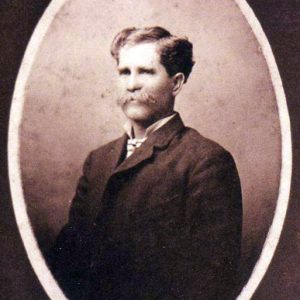calsfoundation@cals.org
Eureka Springs Baby
aka: Eureka Baby
aka: Petrified Indian Baby
The 1880 discovery of a fossilized human child in Eureka Springs (Carroll County) was not revealed as a hoax until 1948. The find was exhibited locally and then around the state. Within a year, the carving—known variously as the “Eureka Baby,” the “Petrified Indian Baby,” or as a Hindu idol—had been exhibited in St. Louis, Missouri; Galveston, Texas; and New Orleans, Louisiana. It was also reportedly en route to the Smithsonian Institution in Washington DC at the time of its disappearance.
This hoax was the brainchild of Henry Johnson, a Scottsville (Pope County) merchant who closely modeled his deception on the nationally famous Cardiff Giant. This massive stone man was “discovered” in 1869 in Cardiff, New York, and publicly acknowledged as a hoax the following year in a lawsuit that pitted its originator against showman P. T. Barnum. In both the Cardiff and Eureka Springs hoaxes, the stone likenesses were created by tombstone carvers, buried, and then unearthed by well diggers, and both made money for their owners.
In 1880, many newspaper writers appeared convinced of the validity of the Eureka Springs find, calling it “proof of pre-Adamic generations” or predicting that it would “revolutionize geology.” There were some skeptics, however. L. J. Kalklosch, Eureka Springs’s earliest historian, while never claiming to have viewed the baby, agreed with those who called it “a humbug.” Other newspapers expressed doubts, but most telling of all was the Arkansas Gazette, which opined of the “petrified Indian baby” that “there has never been such a thing before. Indian blood was never claimed for the Cardiff giant.”
Henry Johnson had the means and the connections to undertake such a scam, as he was related to Marcus Lafayette Kelly, a Fayetteville (Washington County) tombstone carver. Kelly created the eighty-five-pound, twenty-six-inch-long statue of a child, which was later encased in a thick coating of clay and ash, aging the marble to a mottled blue-gray color. Around the time it was being carved, Thomas Campbell (also of Pope County) and J. B. Hallum of Texas arrived in Eureka Springs. Hallum bought a piece of land near town and hired Campbell to dig a well on it. On October 1, Campbell, working alone, supposedly dug up the baby at a depth of four feet.
In 1880, Eureka Springs was just a year old, but belief in the curative powers of the town’s many springs had attracted hundreds of health-seekers. Thus, in addition to the townspeople, there was a large audience of invalids eager to see the latest attraction. Johnson (who established his claim by supposedly buying a share in the baby’s ownership), Hallum, and Campbell charged ten cents to view the find, later raising the rate to thirty-five cents. Within three months, having exhausted local interest, the men took their creation to Clarksville (Johnson County) and then Russellville (Pope County) before selling out to two Little Rock (Pulaski County) investors for a reported $4,600. The baby changed owners again over the course of its travels.
In 1948, after all of the participants were dead, T. J. Rowbotham gave an interview to the Arkansas Democrat, revealing the connections between the participants. Rowbotham’s brother John lived in Eureka Springs in 1880 and rented a room to Henry Johnson; Hallum was the Rowbothams’ brother-in-law and lived nearby. Campbell surely knew Johnson back in Pope County because he used Johnson’s business partner as a character witness when making a sworn statement concerning his “find.”
T. J. Rowbotham also revealed that Johnson and Kelly were related by marriage, and he stated that the baby had been seen in an unidentified Chicago, Illinois, museum, complete with information on its origins. To date, the carving has not been located, but it is known that it did not end up at the Smithsonian. However, a similar stone baby of unknown origin can be found on display at the Museum of Discovery in Little Rock.
For additional information:
“Arkansas’ Famous ‘Petrified’ Baby.” Arkansas Democrat Sunday Magazine. February 15, 1948, p. 8.
Burnett, Abby. “The Eureka Baby—Human or Hoax?” Carroll County Historical Quarterly 55 (March 2010): 13–18.
Kalklosch, L. J. The Healing Fountain, Eureka Springs, Ark., a Complete History. Eureka Springs, AR: 1881.
Schaefer, Susan. The Bear Hunter, the Bareback Rider and the Governor…and Other Stories of Early Eureka Springs. Springfield, MO: Color Graphics, 2004.
Abby Burnett
Kingston, Arkansas
 Folklore and Folklife
Folklore and Folklife Marcus Kelly
Marcus Kelly  T. J. Rowbotham
T. J. Rowbotham 




Comments
No comments on this entry yet.